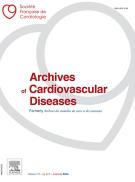Characterization of left atrial strain in left ventricular hypertrophy: A study of Fabry disease, sarcomeric hypertrophic cardiomyopathy and cardiac amyloidosis - 04/04/25
 , Frédérique Dubé a, b, d, Soumaya Sridi-Cheniti a, b, Julien Ternacle a, b, e, Stéphane Lafitte a, b, e, Patricia Réant a, b, e, f
, Frédérique Dubé a, b, d, Soumaya Sridi-Cheniti a, b, Julien Ternacle a, b, e, Stéphane Lafitte a, b, e, Patricia Réant a, b, e, fGraphical abstract |
Highlights |
• | LA reservoir strain was significantly more reduced in CA versus FD and HCM. |
• | LA reservoir strain was worse in CA versus FD and HCM, for the same LV GLS value. |
• | LA reservoir strain was associated with adverse outcomes in our LVH population. |
• | LA reservoir strain was associated with adverse outcomes in our CA subgroup. |
Abstract |
Background |
Patients with left ventricular hypertrophy (LVH) often maintain preserved left ventricular ejection fraction in the early stages of the disease. There is a need to identify simple and reliable variables beyond left ventricular ejection fraction to recognize those at risk of developing adverse clinical outcomes.
Aims |
To examine left atrial (LA) strain in patients with hypertrophic cardiomyopathy (HCM), cardiac amyloidosis (CA) and Fabry disease (FD), pathologies known to cause LVH, and the relationship between LA strain and adverse clinical outcomes.
Methods |
In this retrospective cohort study, LA strain was measured and compared among patients with HCM, CA and FD. Relationships between LA and left ventricular strain, and LA strain and adverse cardiovascular events were evaluated. The primary outcome was first occurrence of cardiovascular mortality, device implantation, heart failure hospitalization, new-onset atrial fibrillation or stroke.
Results |
A total of 191 patients were included (24 with FD, 87 with HCM, 80 with CA). LA reservoir strain was highest in patients with HCM (26%, interquartile range [IQR] 20%, 32%), followed by those with FD (20.5%, IQR: 14%, 27.8%) and CA (11%, IQR: 7%, 18.8%) (P<0.001). LA strain correlated well with left ventricular strain in patients with LVH, with CA showing the best correlation (r=−0.70, 95% confidence interval [95% CI]: −0.80 to −0.56; P<0.001). Multivariable Cox regression analysis showed that LA reservoir strain was significantly associated with the primary outcome in all patients (hazard ratio: 0.91, 95% CI: 0.84 to 0.99; P=0.03) and in those with CA (hazard ratio: 0.90, 95% CI: 0.82 to 0.99; P=0.023).
Conclusions |
LA strain was more reduced in CA than in FD and HCM, probably as a result of atrial wall infiltration, and was associated with adverse clinical outcomes in our heterogenous LVH population and patients with CA.
Le texte complet de cet article est disponible en PDF.Keywords : Amyloidosis, Fabry disease, Hypertrophic cardiomyopathy, Left ventricular hypertrophy, Global longitudinal strain
Plan
| ☆ | X post (Tweet): Left atrial strain is a key marker of adverse outcomes in LVH. A study of 191 patients shows that LA strain is most reduced in cardiac amyloidosis vs. hypertrophic cardiomyopathy and Fabry disease and correlates with adverse clinical outcomes. #Cardiology #LVH #Research. |
Vol 118 - N° 4
P. 231-240 - avril 2025 Retour au numéroBienvenue sur EM-consulte, la référence des professionnels de santé.
L’accès au texte intégral de cet article nécessite un abonnement.
Déjà abonné à cette revue ?

